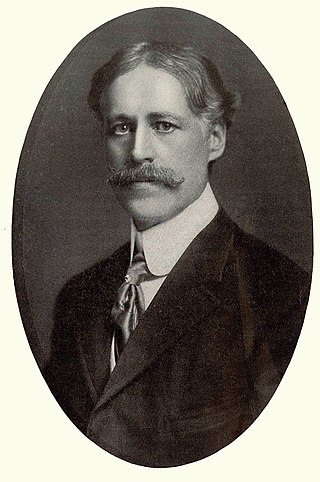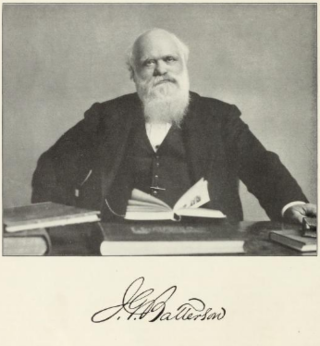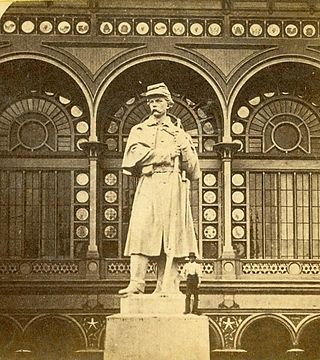
Karl Theodore Francis Bitter was an Austrian-born American sculptor best known for his architectural sculpture, memorials and residential work.

William Ordway Partridge was an American sculptor, teacher and author. Among his best-known works are the Shakespeare Monument in Chicago, the equestrian statue of General Grant in Brooklyn, the Pietà at St. Patrick's Cathedral in Manhattan, and the Pocahontas statue in Jamestown, Virginia.

Giuseppe Ceracchi, also known as Giuseppe Cirachi, was an Italian sculptor active in a Neoclassic style. He worked in Italy, England, and in the United States following the nation's emergence following the American Revolutionary War.
Alexander Hamilton was the first United States Secretary of the Treasury and one of the Founding Fathers of the United States of America.

James Goodwin Batterson was an American designer and builder, the owner of New England Granite Works from 1845 and a founder in 1863 of Travelers Insurance Company, both in Hartford, Connecticut. He introduced casualty insurance in the United States, for which he was posthumously inducted into the Insurance Hall of Fame (1965).

Carl H. Conrads was an American sculptor best known for his work on Civil War monuments and his two works in the National Statuary Hall Collection at the U.S. Capitol in Washington, D.C. He was also known as Charles Conrads.

The American Volunteer – also known as The American Soldier – is a colossal granite statue that crowns the U.S. Soldier Monument and forms the centerpiece of Antietam National Cemetery in Sharpsburg, Maryland. The monument is also known as the Private Soldier Monument.
The New England Granite Works was a firm incorporated in Hartford, Connecticut on June 16, 1871 by James G. Batterson. It was notable for creating a large number of works in the New England area until it was dissolved on June 26, 1926.

Ludwig van Beethoven is a series of sculptures of Ludwig van Beethoven by German-American sculptor Henry Baerer. Versions are displayed in Central Park and Prospect Park in New York City, as well as Golden Gate Park in San Francisco. The sculpture in Central Park was dedicated on July 22, 1884. It includes two bronze statues, including a bust of Beethoven and an allegorical female figure on a polished Barre Granite pedestal.

An outdoor bronze bust of Giuseppe Mazzini by Giovanni Turini is installed in Central Park's Sheep Meadow, in Manhattan, New York. The sculpture was commissioned by a group of Italian-Americans and was dedicated in 1878 with a speech by American poet William Cullen Bryant. It sits on a granite pedestal, which includes two inscriptions that translate to "thought and action" and "God and the people". In 1994, the bust was restored by the Central Park Conservancy.

An outdoor bronze portrait bust of German writer Johann Wolfgang von Goethe by sculptor Karl Fischer is installed on the south side of Bryant Park in Manhattan, New York. It is a replica of an iron and copper bust created by Fischer around 1832, the year of Goethe's death. Acquired by the Goethe Society of America in 1987, it was displayed at the Metropolitan Museum of Art until it was relocated to Bryant Park in 1932. Following its installation there, the iron and copper bust was replaced with a bronze casting and dedicated on February 15, 1932. The sculpture was refurbished in 1992 by the Bryant Park Restoration Corporation. The sculpture sits on a Swedish black granite pedestal.

Admiral David Glasgow Farragut, also known as the Admiral Farragut Monument, is an outdoor bronze statue of David Farragut by Augustus Saint-Gaudens on a stone sculptural exedra designed by the architect Stanford White, installed in Manhattan's Madison Square, in the U.S. state of New York.

Vincenzo "Vincent" Miserendino was an Italian-American artist and sculptor born in Sicily and active in New York City during the first half of the 20th century. He studied art first in Palermo at the age of 13 and then in Rome at the Accademia di Belle Arti di Roma. He immigrated to the United States in 1894 at the age of nineteen, and settled on the lower east side of Manhattan, working in many odd jobs while trying to establish himself as an artist.

Alexander Hamilton is a marble bust portrait of American Founding Father Alexander Hamilton, done in the style of a Roman Senator, by the Italian sculptor Giuseppe Ceracchi. Ceracchi also created many replicas, in both marble and plaster. The bust was later used as a model for several notable sculptures, paintings, and other works featuring Hamilton.

George Washington is a marble bust portrait of George Washington, done in the style of a Roman emperor, by the Italian sculptor Giuseppe Ceracchi. It was created as part of a campaign by Ceracchi to build a larger monument to Washington. The bust was thought by many to be one of the most lifelike. It was later used as a model of Washington for works by other sculptors and engravers.

Giovanni Turini was an American sculptor, born in Verona, Austrian Empire. He immigrated to the United States in the late 1860s. He is best remembered as a portrait and historical sculptor.

George Washington was a life-size marble statue of George Washington, done in the style of a Roman general, by the Venetian-Italian Neoclassical sculptor Antonio Canova. Commissioned by the State of North Carolina in 1815, it was completed in 1820 and installed in the rotunda of the North Carolina State House on December 24, 1821. The building and the statue were destroyed by fire on June 21, 1831. This work was the only one created by Canova for the United States.

General Israel Putnam is a monumental statue in Hartford, Connecticut, United States. Located in the city's Bushnell Park, the statue was designed by sculptor John Quincy Adams Ward and honors Israel Putnam, a military officer in the Continental Army during the American Revolutionary War. The statue was largely paid for by a donation from judge Joseph P. Allyn and was dedicated in a large ceremony in 1874. It was one of the first statues to be erected in the park, which nowadays houses several other monuments to famous Connecticut residents. From an artistic standpoint, the statue has received mixed reviews from critics.

Dr. Horace Wells, also known as the Horace Wells Monument, is a monumental statue in Hartford, Connecticut, United States. The statue, located in the city's Bushnell Park, was designed by sculptor Truman Howe Bartlett and dedicated in 1875 in honor of Horace Wells, a dentist who was a pioneer in the use of anesthesia.




















